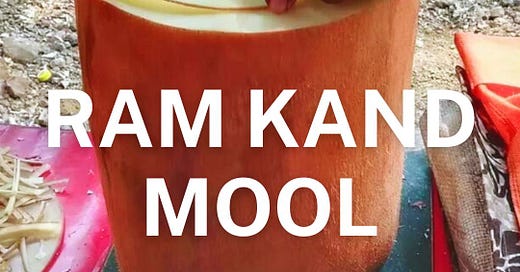A Sweet Surprise at Chor Bazaar: Ram Kand Mool
A walk down the childhood lane and finding something new!
Hello Enthusiasts,
Welcome back to our 13th educational newsletter, where we explore fascinating botanical finds. This time, I've got an intriguing story to share from my recent visit to Pune's lively Chor Bazaar (a noisy market). It's a tale that will make your taste buds happy and make you really curious.
Just imagine - My friend and I had barely set foot in Chor Bazaar when I stumbled upon something truly captivating in a matter of minutes. Amidst the vibrant stalls spread one after the other, I came across a man with an intriguing chunk that resembled a tree bark. He was carefully slicing thin layers and selling for just Rs.10. Naturally, we decided to try it.
It had the familiar texture of sweet potato but with an even sweeter twist. The vendor proudly called it 'Ram Kand' and shared that, apart from being a delectable snack, it also packs a punch of benefits for our bodies.
As I savored this newfound delight, the crowd around us grew. Unfortunately, the buzz left me with more questions than answers. It was a brief encounter, but it left me eager to learn more about this intriguing plant.
Chor Bazaar, with its mix of old treasures, whisked me back to the nostalgic charms of my childhood. We discovered many things of the past- from vintage coins and notes to statues, jewelry, electronics and timeless brass and copper cups. The market was a treasure trove of memories that added an extra sprinkle of magic to our Ram Kand discovery.
Ram Kand Mool, a drum-shaped tuber, is mainly found in Indian states like Karnataka, Andhra Pradesh, Telangana, and Maharashtra. It's not very well-known, and its true identity is a bit of a puzzle. Some research suggests it might be related to the Century plant (Agave Sisalana or Sisal), which adds a layer of intrigue to this tuber.
Adding to the intrigue, a botanist named Dr Ali Moulali made an interesting discovery when he approached a vendor selling Ram Kand Mool and exchanged Rs 1,000-2,000 for insights into the snack's source. Around the same time, Dr. Hemadri was conducting his research on this enigmatic tuber. The vendor revealed that the snack was made from Kitta Nara fiber, typically used in agave fiber production. What's fascinating is that he clarified that it wasn't the root but rather something that grew above the ground, adding another layer to the mystery.
Vendors often claim that Ram Kand Mool was the only food Lord Ram, a highly respected Hindu deity, had during his exile in the forest with Sita and Lakshman. They say it can cool you down in hot weather, satisfy your hunger and thirst, and even offer medicinal benefits.
People believe it's good for your stomach, can quench your thirst, and keep you feeling full. Some folks even use it in powdered form as part of traditional medicine. But here's a word of caution: There's a concern that these tubers might contain alkaloids that could be harmful if you eat a lot. That's why vendors usually serve thin slices. So, it's important to be careful.
Now, if any of you have more info on Ram Kand Mool, feel free to share it in the comments below. We're on a quest to learn more about this interesting tuber, and your insights are always welcome.
Petaling off now,
Khadija




